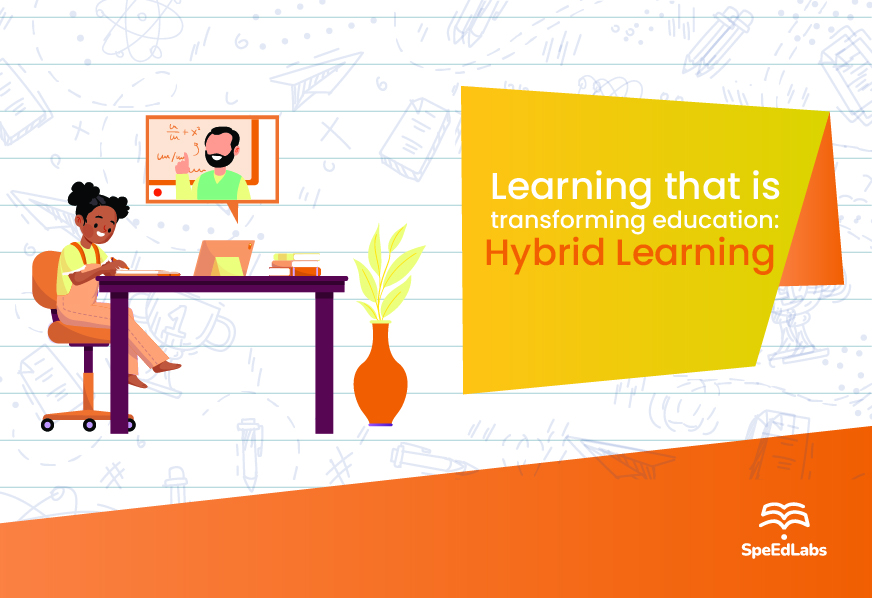Hybrid learning has been a trend, and not just since the pandemic. The method has obligated schools to reformat and restructure instruction.
The epidemic pushed educational institutions and instructors to experiment with using the internet to deliver lectures. Hybrid learning is a method of teaching and learning that incorporates both face-to-face and online activities. This type of education assists students in progressively transitioning to self-motivated learning.
Hybrid learning and its impact on education
The notion of hybrid learning, sometimes known as a “blended” form of learning, has been around for over a decade but has gotten a lot of attention in recent months as an action of the pandemic’s unparalleled worldwide catastrophe. It would have seemed much further a year ago if someone had said that all education in the upcoming quarters would take place online and that learners (and professors) would not be coming to schools at all. In this blog, we will be discussing the increasing use of hybrid learning and how teaching platforms are using it effectively.
The foundations that make hybrid learning desirable, advantageous, and unavoidable for learning institutions point to the same conclusion: online platforms may be an excellent tool and support for non-school teachers’ actual coaching.
Many of the traditional Teachers are technically not so profound, but their teaching style is incomparable. Rather than replacing them, institutions must focus on making these instructors tech-savvy so that students can remain comfortable with the learning process. SpeEdLabs is one of the few institutions that allow educators to empower students by transferring their relevant knowledge, expertise, pedagogical skill, and local trust to students at a low cost while also using appropriate technology.
Moreover, it helps students learn and grow together, as a class, no matter where they are present, by using the opportunities that remote learning provides—asynchronous learning, self-paced lessons, personalized pathways, additional one-on-one touchpoints, and so on.
Advantages of Hybrid learning
- Increased adaptability: A hybrid method provides students more discretion over when, where, and how fast they study. Increased attendance and involvement in classes are typically the results of this freedom.
- Instant Response: Customized exams, participation in live lectures, and live conversations with professors are examples of methods to provide students with real-time information that is very beneficial to their learning.
- Use of tech to broaden the scope of personalization and engagement: Artificial intelligence will aid in the customization of learning to fit various learning styles, resulting in improved learning results. Technology may assist make the hybrid learning environment more effective in many ways, including gamification, self-paced learning, and short films with interleaved activities. SpeEdLabs is Artificial intelligence-based, which helps students to track their real-time results and enhances the learning experience.
- Students become self-targeted learners: In a hybrid learning method, the student bears a significant share of the workload for completing the learning task. It allows the learner to gradually transition to a self-directed learning style, which is highly successful in the long term, especially for higher education.
- Intricate tests and reporting: The Hybrid learning model makes it possible to conduct comprehensive student evaluations, peer optimization, and detailed and accurate reporting through technology.
Let us have a look at some of the statistics:
- Education institutions in the post-pandemic world are trying to attract prospective students to enrol for coaching; the numbers are down by half.
- 1.5 lakh students departed for their homes in India’s coaching hub, Kota, and are still not ready to return to the regular classroom.
- Coaching centres did not even make up half of their annual income due to the epidemic.
- Around Fifty-nine per cent of students are inspired by the hybrid form of learning.
- Eighty-one percent of kids yearn for face-to-face connections with instructors and peers.
- More than 70% of students fail to take enough notes and cheat on examinations.
How to make Hybrid learning more effective and student-friendly?
- Take attempts to bridge the “Digital Divide,” which might be a substantial obstacle to remote instruction equity.
- Parents and guardians play an essential role in a kid’s education by ensuring that the student completes the work that he has allotted.
- Since teaching will have to be more meaningful, teachers will need to restructure their classes in a focused and intentional manner.
- Technology has to be used to keep track of where pupils lack behind and make the teaching-learning process more interactive.
- The concept of “one-size-fits-all” has to be abandoned. With diverse pupils and learning styles, the new method is easy and relevant.
Hybrid Learning: The need of the hour
Hybrid learning covers in-depth analysis of the concepts and is student-oriented. For brilliant, coaching centres must be technologically equipped and implement methods to supplement their in-class efforts. Evaluation of learning, accuracy, and endeavor is what SpeEdLabs provides its users.
Key Takeaways
Blended Learning is assisting in changing the way we think about education and reducing many of the conventional obstacles. Furthermore, its capacity to minimize absences and mitigate the negative consequences of any delays can ensure that students get the most out of their education.
Also published on Medium.
